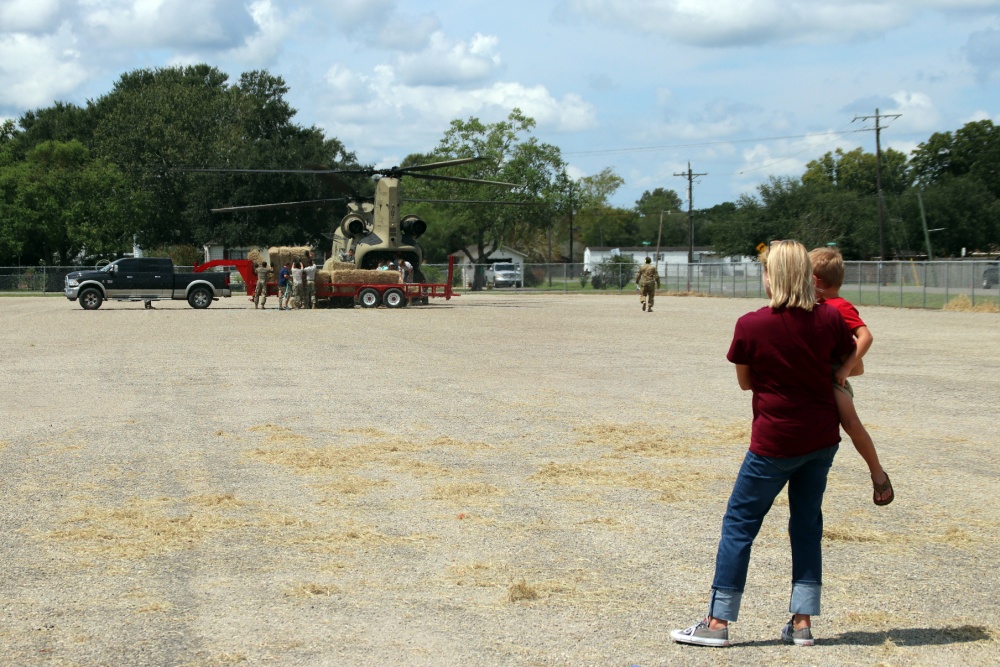 Photo By Sgt. Steve Johnson | Soldiers and Airmen from the Texas Military Department loading hay bales onto Chinook helicopters are joined by civilians in Hamshire, Texas, September 5, 2017. Texas Military Forces are using air assets to support local cattle ranchers protect their herds from starving, by air dropping hay bales to flooded areas.(U.S. Army Photo by Sgt. Steve Johnson/Released)
Photo By Sgt. Steve Johnson | Soldiers and Airmen from the Texas Military Department loading hay bales onto Chinook helicopters are joined by civilians in Hamshire, Texas, September 5, 2017. Texas Military Forces are using air assets to support local cattle ranchers protect their herds from starving, by air dropping hay bales to flooded areas.(U.S. Army Photo by Sgt. Steve Johnson/Released)
HAMSHIRE, TX, UNITED STATES
09.05.2017
Story by Sgt. Steve Johnson
100th Mobile Public Affairs Detachment
HAMSHIRE, Texas -- Soldiers and airmen from the Texas Military Department joined forces with civilians from the city of Hamshire, for “Operation Hay Drop,” Sept. 05, 2017. The goal of the operation was to feed the region's cattle that had been stranded by Hurricane Harvey related flooding.
The soldiers and airmen, along with CH-47 Chinook helicopters from Texas and Ohio National Guard units, local law enforcement, ranchers and farmers organized the operation as a way to ensure livestock across a five county area were fed. High floodwaters have made reaching the animals by land impossible for over a week. The operation targeted an estimated 10,000 animals across an area of over 50,000 acres.
This mission was a key part of ensuring that once the rescue missions wound down, the long term needs of Texas communities would be addressed.
“It’s important for the Texas Military Department to use the assets we have on hand to help protect the livelihoods of people who have been impacted by the floods,” said Texas National Guard Maj. Alicia Schweitzer, 71st Troop Command. “This affects people’s lives from today to months down the road, if we don’t protect their livestock; their communities aren’t going to survive in the long run.”
Cattle ranches make up a significant part of the local economy in Hamshire. The benefits of the hay drop by Texas Military Department personnel were greatly appreciated by the residents of the small town that depend on it.
“The cattle industry in this area is a $25 million dollar a year industry. Losing that type of dollar amount would be a tremendous hardship on the community,” said Tony Viator, a lieutenant with the Jefferson County Sheriff’s Department, who was helping with the operation.
With much of his jurisdiction still reeling from Hurricane Harvey, Viator was glad to have access to the resources Texas Military Department could bring to the region.
“We have a five-county area that due to the flood waters has approximately 10,000 head of cattle that are trapped on islands, unable to be fed and taken care of by their owners. We asked the Texas Army National Guard for help, and they have done an outstanding job, giving us everything we needed, from pilots, to logistics, ground support, and help loading the aircraft,” said Viator.
Before the operation ended for the day, Texas soldiers and airmen had loaded and air dropped approximately 1000 bales, and residents of Hamshire, like rancher Danny Drawhorn were thankful for the help in the wake of Harvey.
“I have about 50 head of cattle in my pasture, probably about $100,000 worth of cattle, plus they’ve all got calves with them, “ said Drawhorn. “This part of the country is America's table-top and when we get 42 inches of rain like we did, it’s virtually impossible to get hay back there. This air-drop has just been tremendous for us. “